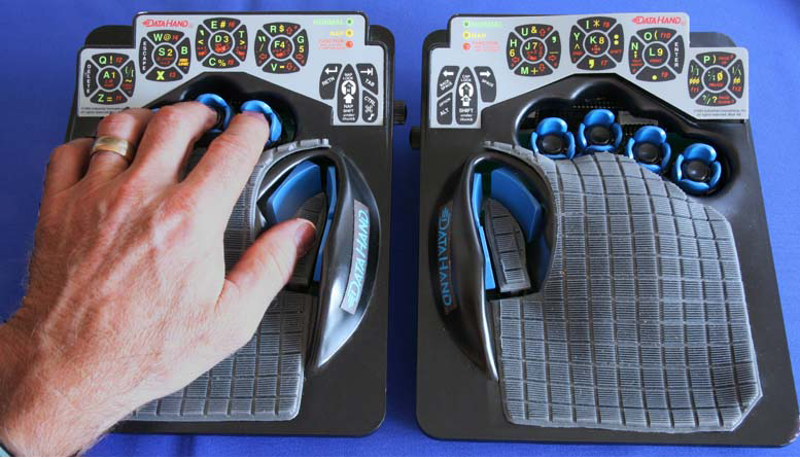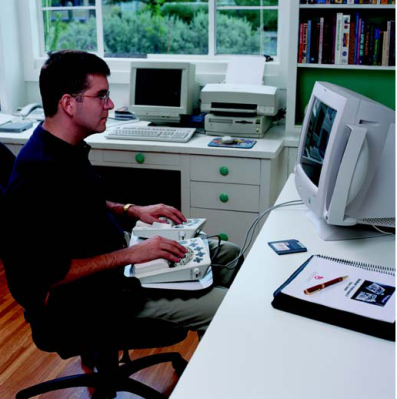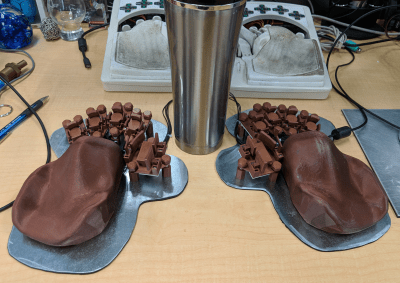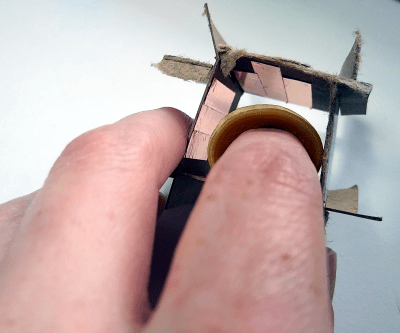If you had debilitating pain from repetitive stress injury in the 1990s, there were a lot of alternative keyboard options out there. One of the more eye-catching offerings was the DataHand keyboard made by DataHand Systems out of Phoenix, AZ. The DataHand debuted in 1993 with a price tag around $2,000. While this is admittedly pretty steep for the average consumer, it was well within the IT budgets of companies that wanted to avoid workman’s comp claims and keep their employees typing away.
In theory, this is holy grail territory for anti-RSI keyboards. The DataHand was designed to eliminate wrist motion altogether by essentially assigning a d-pad plus a regular push-down button to each finger. The layout resembles QWERTY as closely as possible and uses layers to access numbers, symbols, and other functions, like a rudimentary mouse.

Ergonomic to the Max
Typing on the DataHand is supposed to be next to effortless. The directional switches are all optical, which probably has a lot to do with the eye-popping price point. But instead of being spring-loaded, these switches use magnets to return to the neutral position.

It really seems like the inventors of the DataHand tried to make their product as ergonomic as possible. The photo above shows one of the first models — a DH200 dated 1993. Those knobs on the thumb sides will raise and lower the depth of the finger wells in the Z direction.
Later models like the Professional and Professional II are even more customizable. They came with two sizes of palm rests instead of that gray rubber grid, and have a second set of dials that brings the finger wells closer to your palm or move them away, depending on the length of your digits. It could really only be better if each set of switches could be adjusted independently.
The Professional II also came with The LapLander™, a lap desk designed to make typing even more comfortable. If that’s still not good enough, you could get the DataChair™, which is your standard 90s task chair with the DataHand halves mounted at the ends of the armrests.
Below is a compilation of informational videos about the DataHand Professional II. Although there’s a bit of repetition, it’s nothing stressful or injurious, and there’s a lot of good shots and information about this model.
Gone But Not Forgotten

Here’s the good news: there have been a couple of attempts to recreate this magical keyboard since then. One of them, the DodoHand project, is covered in a lengthy discussion thread on geekhack going back several years. The project has been forked by several people, and it looks like [JesusFreke]’s lalboard project is pretty much finished.
Are you as intrigued by the DataHand as I am? I found a couple of sites out there with a lot of good pictures and user experience stories. This person made a version of the DataChair™ with the halves mounted vertically so he can type while his arms are hanging down at his sides.
 The day I learned about this keyboard, I was so hyped about the 5-way input mechanism that I made a prototype that doesn’t have moving switches. Basically, I took one of those rubber fingers that bank tellers and office workers use and stuck a piece of copper tape on each of the four sides. Then I made a little finger box with copper tape contact pads on each wall.
The day I learned about this keyboard, I was so hyped about the 5-way input mechanism that I made a prototype that doesn’t have moving switches. Basically, I took one of those rubber fingers that bank tellers and office workers use and stuck a piece of copper tape on each of the four sides. Then I made a little finger box with copper tape contact pads on each wall.
The prototype doesn’t do anything. but it was interesting to consider how it might work if you just moved your finger around. I’d much rather have tactile feedback, especially with such a strange new system and layout.
I think this concept is really cool, though I would have to try one to know for sure (and I would love to try one). If you have one to sell, hit me up. In the meantime, I might have to try making at least one finger’s worth into a macro board. I think I’ll call it the DataDigit.
















Looks like something one would use in a sci-fi spaceship. Those interfaces aren’t practical either.
You mean like the one in Contact?
Well played. :-D
By the sound of it the Datahand is eminently practical, so there must be some problem with your simile.
It’s so impractical that I’ve been using it as my primary interface for the last 10+ years. :-)
I simply can’t go back to normal keyboard, the difference in comfort is like night and day.
That’s very cool. I did a device for physical rehab many years ago that had a clickable trackball under each finger, one under the palm, and the whole device was an optical mouse. It was a challenge to cram all of that into HID reports but it worked extremely well if you like really annoying interface devices. I like the idea of the D-pads if you really want to make a productivity tool. In defense of the multi-trackball deice it worked great for their measurement gathering needs but it would never have worked as a useful input device for gaming or data entry. This was the early days of USB/HID, Windows 95 wasn’t very USB friendly, etc. Quite a challenging project.
Reminds me of the various, one handed, chorded input keyboards, e.g. https://twiddler.tekgear.com/ . Nice in theory but, like any other alternative key board, unlikely to catch on beyond a small, dedicated group.
I can kind of see what you mean, I don’t think the Datahand has chording though, its focus is on relieving RSI pain, so I suspect any modifier keys will hold until the next switch press (was going to say key press, but that’s wrong).
On another note (not chord, haha!), I would definitely have bought one of those Twiddler keyboards if they were less than about £50, but they were 4 times that. They actually cost more than a good mechanical keyboard.
I actually bought a Twiddler3 on my quest for a walkable-keyboard, but it’s so bad for the price! Tiny, finicky uploader, bad buttons, and you need to modify it pretty extensively to make it ergonomic in the hand (by essentially making a contoured spacer to change where it sits in the palm). You also can’t really use the inbuilt chord combinations, as they are very poorly laid out (the chords are sorted alphabetically, rather than letter frequency!).
Also, there were a couple of studies performed to evaluate Twiddler style input and most people could only get to between 20 and 40wpm flat out. One guy got to 70wpm, which is impressive though!
Thanks for the benefit of your experience, Hamish. How has your quest for a walkable-keyboard fared since the Twiddler 3? Perhaps the most compelling I’ve seen in recent times has been the Decatxt, but I’ve not actually seen that for sale.
It’s not a chorded keyboard (any more than a normal keyboard, at least), so the learning curve isn’t nearly as steep. The default layout on the datahand is a qwerty-like layout that’s super easy to get started with, although I went with a modified dvorak-like layout :). The most annoying thing for me to re-learn was cursor control. arrow keys, home, end, along with the various modifiers that go along with it. It’s surprising how automatic that becomes to someone, and how annoying it is when it’s *not* automatic (yet). :)
But yeah, I certainly don’t expect this to become commonplace, and it doesn’t need to. I mostly designed it for myself. But I’m a big fan of open source projects, so I released it so others could use it, modify it, learn from it, etc.
Those things remind of the preposterous Microsoft Natural Keyboard. I actually tried using one at a show, and it took me six tries.
After using various Microsoft Natural keyboards for 20+ years, whenever I use a regular straight keyboard it’s uncomfortable how the straight keyboard twists my wrists.
If I were doing it, I’d go for 3 positions per finger, straight push, lift and depress, with maybe 6 buttons under the thumb which could include modifiers because IMO using thumb with a finger is more natural than trying to coordinate say a pinkie push with a middle finger push. Possibly also you could have a 2 pressure palm push modifier, light forward push for caps, harder/further for symbol shift.
Reasoning is that fingers don’t like doing sideways exertion much and balancing up and down movements most likely to keep tendons centered up and avoid RSI probs. Thumbs being more mobile can cope with a circle of displacement.
I built a keyboard exactly like you’re describing, though with only one level of pressue on the palm (as a row of switches)! I also built a few variants. Straight-push also became curl-inwards though — the fingers don’t like pushing out as much as curling in.
I also built a keyboard that used joysticks on each of the digits, and I concur with your assertion that fingers don’t like pushing sideways much! However, they were totally fine when I was using side buttons, as long as the travel distance was tiny and the switch didn’t require much force. Or when pressing downwards but a little offset horizontally (like having a 2×2 grid of flat switches for one finger).
With regards to chording, it becomes really easy to coordinate various fingers in combination — I’ve found in my development that it takes me around two hours of use to become comfortable using any pair of fingers to type together, though I have had quite a bit of practice with weird keyboards, so I may not be the best casestudy
The datahand/lalboard is not a chording keyboard, so you would never need to do a pinky+middle finger push. The majority of commonly used letters are mapped to the “down”, “north” and “south” keys. And those that do require a sideways push are mostly on the first and second finger, which are more suited to that movement. The other side keys are relegated to lesser used symbols and the like.
DataHand has two levels on thumb cluster. (on the thumb down position) And it’s mildly infuriating at times.
Btw, the left thumb is shift, with Caps Lock on 2nd level. And right thumb is NAS (numbers and symbols) with NAS Lock on second level.
And the movement to the side isn’t actually problematic, because the finger travel is extremely short (a few millimeters, if I had to guess).
Also, the fact that vanilla DH is basically querty with 4 letters relocated helps a lot with the learning curve (which is still extremely steep).
Going fancy and doing it without firm background into ergo research might sound nice… but the original author of DH actually did extensive research into this problem. And it shows. As I commented above, I’ve been using it for 10+ years and wouldn’t have it any other way. It’s so comfortable to the point that I don’t think there’s any room for improvement (in the core functionality).
Yeah, that’s one thing I left out when I designed the lalboard. It only has a single “down” for the thumb. I never used the “caps lock” or “NAS lock” functionality on my real datahand anyway. That, and having a 2 stage key like that is a bit more complex than I wanted to try and tackle.
Yeah, I’m with you about the limited usefulness of caps/nas lock.
Btw, DH even sends the “shift press, caps press, caps release, shift release) combo for the caps, which makes it rather useless for (say) mod key remapping.
Plus, if you ever wanted to get something like a lock on lalboard, you could probably implement it in firmware with single level presses: “nas, then shift” or “shift, then nas”.
The only thing I keep thinking about is a second switch on the thumb cluster towards the palm. Might make for some nice free keys for things like Mod4. Well, that, and usb-a/c for gnubby somewhere within reach… but that’s easy with some sticky tape (and for a very limited audience to boot).
if they use magnets to recenter then why not use hall sensors? you could easily detect the change in the field.
Maybe it’s magnetic field density? I had some difficulty getting a couple of hall sensors to function correctly when I had a few magnetic ‘switches’ in the same place. I’d love to get that working though, would make a really cool analog input device
It is something I considered, but I didn’t investigate too deeply. You could either do 1 hall sensor per key, or possibly 1 hall sensor per cluster. My main concerns with “1 hall sensor per key” is cost and placement. You can get hall effect switches for fairly cheap, but I’m not sure if you could get a switch with the performance characteristics needed (super small magnet, only displaced a few mm, and with a mating magnet very close by). And actual linear hall effect sensors are more costly.
And 1 sensor per cluster seems like it would fairly complex. You would have 2^5 combinations of key states/magnetic field configurations to detect.
LEDs and phototransistors are relatively cheap (I think I get them at about $.15 a piece, or about $15 for an entire lalboard’s worth), and work quite well :). That’s what the original datahand used, and that’s what I decided to stick with when designing the lalboard.
What are you gaining with hall sensors, if the IR light detection is cheap, reliable, and dead simple?
Plus, the magnets are definitely different strengths for different fingers (little finger pulls against a different resistance than the rest of them), which would IMO further complicate things.
Data hands are back! Check out the azeron Cyborg. Just bought one out of love for the datahand. May buy the right hand as well to have the full set up